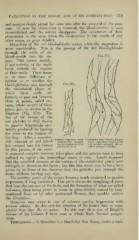Page 669 - My FlipBook
P. 669
VARTATIO^^S IN THE BLOOD, AND IN ITS DISTRIBUTION. 679
and remains deeply pitted for some time after the removal of the pres-
sure. If now the obstruction is removed, the blood-current is soon
re-established and the oedema disappears. The occurrence of these
phenomena is the same when the obstruction is the result of any
other cause, as great debility.
Dlapedesis of the red hlood-globides occurs when the stagnation is
more considerable. This is the passage of the red blood-globules
through the walls of the
blood-vessels into the tis- ^^^- 3^2.
sues. This occurs mainly,
if not entirely, in the capil-
laries without the rupture
of their walls. There seems
to be some difference of
opinion as to whether the
blood-globules pass through ^^'^' ^^l.
the endothelial plates of
which these walls are
formed, or pass out between
them at points, called sto-
mata, where several of these
plates join, as shown in the
diagram (Fig. 372). The
fact of the escape of the
red onlobules is well shown
in passive hypersemia arti-
ficially produced by ligating
the veins in the tongue of
the frog. After a consider-
Normal Capillary, with Capillaries after Passive Ilyper-
able amount of red blood endotheliiun mapped semia : apertures between the
out liy tieatment with cells greatly enlarged—the so-
has escaped into the tissues
nitrate of silver. called stomata (Arnold).
by this process, if the cause
is removed complete recovery takes place and the arteries seem to have
suffered no injury ; the hemorrhage ceases at once. Arnold supposed
that the so-called stomata at the corners of the endothelial plates were
enlarged, as shown in tlie figure ; but this idea seems now to have been
given up in favor of the doctrine that the globules pass through the
tissue without leaving any sign.
The nutritive power of the tissues becomes much weakened in passive
hypersemia if long continued. This gives rise to the sloughing of parts
that bear the pressure of the body, and the formation of what are called
bed-sores, these being prone to occur in great debility caused by long-
continued fever or by other protracted illnesses that notably weaken
the circulation.
Gangrene may occur in case of extreme passive hypememia with
intense oedema. In this case the aeration of the tissues fails so com-
pletely that they die en masse. In this way in a case of Bright's
disease of the kidneys I have seen a whole limb become gangre-
nous.
Thrombosis. -A thrombus is a blood-clot that forms, under a vari-


